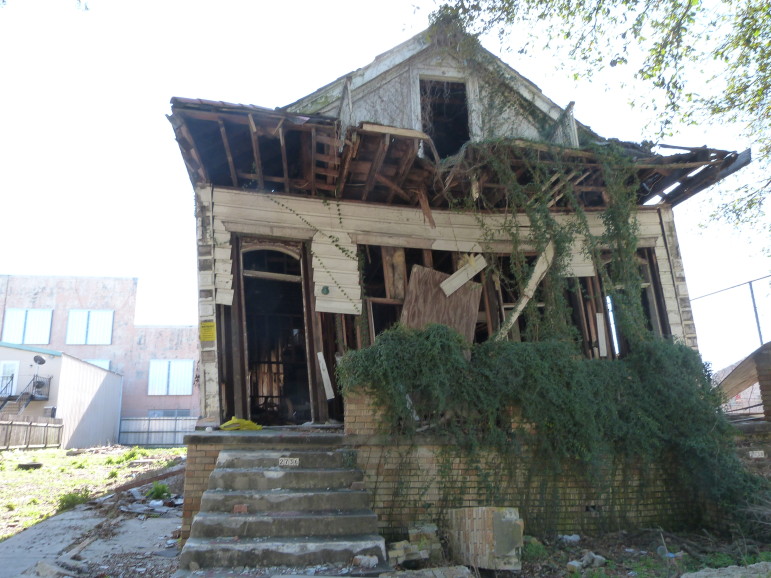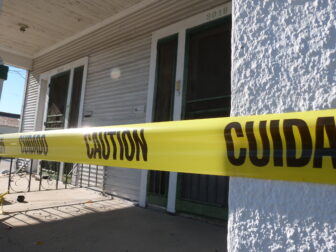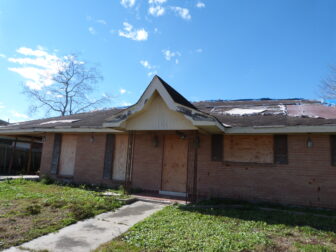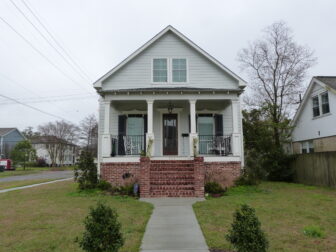
The city keeps track of each victory in the war against blight, listing each address on its website. But when we randomly checked those properties, we found trash, high weeds and houses that had supposedly been demolished. A quarter likely violate city code.
No one would claim that the 9400 block of Colapissa Street in Hollygrove has fully recovered from Hurricane Katrina and the flood caused by the collapse of the city’s levees.
As of June, six of the 14 residential lots were occupied. One house was under construction. The remaining seven were vacant.
Over the past five years, the city has cited eight properties on the block. One, the vacant lot at 9404 Colapissa, is considered a win in the Landrieu administration’s war against blight.
That’s where the Richardson family’s house once stood. In 2011, after being vacant for six years, the house was torn down. 9404 Colapissa was put on the city’s list of remediated properties.
“The house just needed to go,” said neighbor Wendell Bloodworth.
But the current condition isn’t much of an improvement.
When The Lens visited, the lot had succumbed to nature. Weeds and grass were waist-high. The sidewalk was gone, replaced by a shallow pool of water filled with trash and algae. We visited four times from January to June; the condition didn’t improve.
We decided to visit Colapissa Street after Mayor Mitch Landrieu announced that the city had met its goal of dealing with 10,000 blighted properties. We wondered: In the war on blight, what does victory look like?
We learned that in some parts of town, it’s hard to tell the difference between victory and defeat.
- Of 300 properties we surveyed around the city, about one in six were eyesores — high weeds, damaged structures or piles of debris and trash.
- Many more properties where houses had been razed, such 2312 Conti St., had become trash-strewn and overgrown. Based on similar, outstanding cases, they’re likely in violation of city code.
- Of the city’s list of 128 demolished properties, houses were still standing on four: 2736 Banks St., 835 Belleville St. 4532 Citrus Dr. and 219 Maumus Ave. Three were later removed from the city’s list, but the one on Maumus was still on it as of this month — two years after it had supposedly been demolished.
- Several vacant homes were unsecured, creating potential hazards for children or haunts for drug users and criminals.
Taken together, at least a quarter of the properties we surveyed likely fall short of the city’s standards.
Yet in some parts of the city, blight is pretty much a thing of the past. Every property we surveyed in Lakeview was well-maintained. New homes sit on many of those lots.
That’s probably due to market demand as much as city action. Allison Plyer of the Data Center (formerly the Greater New Orleans Community Data Center), told The Lens that the market, not Code Enforcement, will ultimately determine which neighborhoods improve and which remain blighted.
Landrieu has told residents to be patient, that the fight against blight will take time. Our review shows that in some cases, the city is fighting the same battles again and again.
Checking up on city records
Several days after the mayor announced in January that the city had met its goal, we went to its website to see which properties had been remediated. The city cites this data in its monthly BlightStat meetings.
At the time, there were 7,192 properties on the list. To make the list, a property must have been:
- Demolished
- Repaired and judged in compliance with city codes
- Seized and sold at public auction by the Orleans Parish Sheriff’s Office
- Sold by the New Orleans Redevelopment Authority
We sorted through the properties, deleted duplicates and mapped them. Then we randomly chose neighborhoods and started driving.
We ended up visiting 300 properties: 30 in 10 neighborhoods. That’s about 4 percent of all the properties on the city’s list.
300: Properties reviewed by The Lens
52: Had obvious, extreme signs of blight
When we were done, we went to the Landrieu administration with our findings. We asked how they could claim that the city had dealt with 10,000 properties when many of the properties we surveyed appeared to violate city code.
City officials told us they had never promised to hit that goal solely through city action. As The Lens reported in April, that was at odds with earlier statements from City Hall.
Repeat Offenders
Just because an address is on the city’s list of remediated properties doesn’t mean it’s not a drag on the neighborhood.
“You have a lot of wildlife,” Bloodworth said of his street in Hollygrove. “You have raccoons.”
“That’s a lot of the cause of it right there,” he said, referring to the Richardson property — the one on the city’s list of remediated properties.
In many instances, properties have been brought into compliance, only to become derelict and cited again.

One of those, 3016 Leonidas St., is blocks away from Bloodworth’s house in Hollygrove. In 2012, a Code Enforcement hearing officer declared it compliant, but it’s been cited for more violations since.
It’s not hard to see why. When The Lens visited the property earlier this year, it was wrapped in yellow caution tape, and its front steps were crumbling onto the street. Several nearby properties owned by the same company were in similar states of disrepair, including the house next door.
The city’s Office of Performance and Accountability oversees BlightStat. Oliver Wise, head of the office, told The Lens in an interview that the city knows where blight is recurring. Many properties have been cited repeatedly, he said — which means Code Enforcement is doing its job.
“If a property where there is a demolition falls out of compliance in some way, becomes a place where there is illegal dumping, Code Enforcement goes out and cites that property and starts that process all over again.”
But that cycle isn’t reflected in the city’s figures. The city constantly adds properties to its database as properties are torn down, sold or ruled in compliance with code, but rarely does it move one off after it becomes blighted again.

We found obvious discrepancies in our review, such as the four houses that had been listed as demolished but were still standing. Three of those properties were later removed from the city’s list.
At 6146 Stratford Place on the West Bank, the main house was demolished as claimed by the city, but two badly damaged structures on the same lot were still standing.
And some properties listed as remediated may never have been fixed. Being sold at auction puts a lot into someone else’s hands, but it does not necessarily mean the property was fixed up.
Case in point: 4726 Rosalia Dr., sold by the Sheriff’s Office in 2012. When we visited, the renovation seemed to be languishing, and a tattered tarp lay on the roof.
Some neighborhoods languish while others flourish
When it comes to blight remediation, UNO geography professor Peter Yaukey sees big differences among neighborhoods.
“Certainly the classic example, as everyone is aware, is the Lower 9th Ward,” said Yaukey, who did the blight survey that the Landrieu administration cited when it declared that it had reached the 10,000 property mark.
“Lakeview is shockingly more advanced in its return than even Gentilly, right next door. Just right across City Park, there’s a huge difference.”
UNO geography professor Peter Yaukey
Some neighborhoods have rebounded beautifully. “Lakeview is shockingly more advanced in its return than even Gentilly, right next door,” Yaukey saud. “Just right across City Park, there’s a huge difference.”
Indeed, in the part of Lakeview surveyed by The Lens, not a single property could be called “blighted.” Most empty lots we surveyed had been acquired by the owners of adjacent homes through the Lot Next Door program to expand their yards. Newly built homes stood on many other lots where houses had been torn down.
The property at 210 Bragg St. — cleared and rebuilt under Landrieu’s tenure — is an example of city action and the market working together to clear blight.
In November 2010, a month after Landrieu made his blight pledge, the house was razed under the auspices of the New Orleans Redevelopment Authority’s demolition program. In 2012, the lot was sold at a Road Home auction to a developer, who built a new house. It sold last year.

In other neighborhoods we visited, including parts of Hollygrove, Tulane-Gravier and the Lower 9th Ward, blight is a persistent problem.
The remaining neighborhoods The Lens surveyed fell somewhere in between — including a portion of Mid-City, two parts of Gentilly, one in eastern New Orleans and two neighborhoods on the West Bank.
The situation in the Lower 9th Ward was unique in that so few remediated properties on the city’s list had been redeveloped. Fifteen of the 30 properties The Lens surveyed were vacant lots owned by the New Orleans Redevelopment Authority.
In most cases, these publicly-owned lots were clean and the grass was trimmed. They weren’t part of the neighborhood’s resurgence, but they weren’t causing it any harm, either.
During city budget hearings in November, NORA Executive Director Jeff Hebert said interest was so low in the neighborhood that the agency had sold only five of more than 600 properties. Asked what he planned to do with the rest, Hebert replied succinctly: “Cut the grass.”
A proposed amendment to the state constitution, up for statewide vote in November, will allow the city to offer those NORA-owned lots for $100 apiece.
The key to addressing blight: more residents
Plyer, at The Data Center, said the major difference between the neighborhoods that have been cleaned up and the ones that haven’t is not action by city Code Enforcement officials. It’s market demand.
“I don’t know of any research that indicates code enforcement can affect real estate markets.”r
Allison Plyer, The Data Cente
“This pattern is universally the case, not just in New Orleans,” Plyer wrote in an email. “When the value of a home is lower than the cost of construction, banks won’t lend buyers money to rehab homes. For example, a bank won’t lend $150,000 to rehab a home if the value of the home will be only $50,000 once the rehab is done.
“Thus, in neighborhoods where sales are sluggish and prices low, there’s no financing mechanism for buyers to purchase and rehab homes, [and] homes remain blighted.”
Plyer pointed to a 2010 Data Center study recommending that public agencies and nonprofit groups tailor blight strategies to neighborhood markets. In neighborhoods with widespread blight, damaged structures should be demolished and the lots put to use as “community gardens, small parks or water retention areas.”
The New Orleans Redevelopment Authority has, in fact, started to do this with some of its properties.
The study credits much of New Orleans’ post-Katrina blight eradication to public intervention, namely the “billions of federal housing dollars (via the Road Home program, Low-Income Housing Tax Credits, etc.).” However, according to a joint investigation last year by WWL-TV and The New Orleans Advocate, about 1,900 New Orleans properties that received Road Home grants have recently received blight citations.
Those programs “have helped pre-Katrina residents return to the city,” the study found. But they haven’t brought in enough people to bring the city back to its pre-Katrina population, let alone overcome the population decline that began decades before the storm.
“The relationship between blight and population cannot be overstated. In fact, there is no permanent and sustainable means of addressing all 43,755 blighted homes and empty lots in New Orleans [estimated in 2010] without a massive influx of population,” the Data Center said in the report.
The report also recommended stepped-up code enforcement, particularly in low-demand areas where blight is concentrated. But it emphasized that improving the city’s economy will make the biggest difference.
We asked Plyer if code enforcement can spur market demand. She responded, “I don’t know of any research that indicates code enforcement can affect real estate markets.”
City has more options for enforcement
Over the past two years, the administration has spearheaded a number of changes to state and city law to help the city fight blight. Ordinances passed last year by the City Council expanded property maintenance standards on occupied properties.
This year, the legislature passed a law, signed by Gov. Bobby Jindal, that allows the city to clear privately owned vacant lots and charge the owners.
How to report blight:
The city takes complaints from 8 a.m. to 5 p.m., Monday through Friday. Call 311 from a landline within New Orleans, or 504-658-2299 from a mobile phone.
Another bill, which Jindal signed Monday, allows the city to treat litter and sanitation offenses as it does other blight allegations.* House Bill 940 allows the city to issue civil fines, handled in an administrative hearing. Before, they were handled by Municipal Court, which handles state misdemeanors and violations of New Orleans criminal codes.
“This bill is in response to citizen complaints regarding effective enforcement of certain overt quality of life and sanitation violations,” said mayoral spokesman Tyler Gamble, adding that the administration believes the change will streamline the process and deter offenders.
Residents wait
One afternoon this spring, Bloodworth shouted over the roar of his lawnmower as he described what has happened in the neighborhood where he has lived for all but three of his 51 years.
“It was nice. Beautiful, beautiful,” Bloodworth he said of his block before Katrina.
Now only a few houses are inhabited, and the others are falling apart, “an eyesore to the people coming out of their homes. They’ve rebuilt their homes. … They don’t want to come out and look at that, and look at that,” he said, gesturing toward the block’s moldering wrecks.
“That’s an insult, really.”
Bloodworth was not mowing his own yard. Instead, he was working pro bono on the weeds and tall grass that threatened to claim what he calls “Mr. Diggs’ property,” a vacant, unsecured house near his mother’s home.
Seven blocks away on the same day, Hampton Norflin glanced at two blighted houses on a single lot across the street from a commercial property he owns at the corner of Earhart Boulevard and Eagle Street.
The crumbling houses are empty and unsecured. The empty lot behind them, at 8814 Fig St., is littered with garbage, including an impressive collection of discarded tires. The house that used to stand there was demolished, according to city records. But the other two houses on the same property were not.
“It’s ridiculous. Ever since the storm, they’ve been like this,” Norflin said. “I’d like the city to say something about it, get it fixed up.”
A few days later, the Neighborhood Conservation District Committee approved a city request to demolish one of the two houses. The permit application said it was a “public nuisance.” As of early June, it had not been demolished.
Lens staff writer and co-founder Karen Gadbois contributed to this report.
*Correction: This story originally said that House Bill 940 hadn’t been signed yet, but Jindal signed it into law on Monday. (June 24, 2014)



Please do not encourage the “public” to report blight (it has been 9 years) by giving them a phone number and telling them what city employees will do. I personally have suffered from this kind of abuse when a city employee came out and took a picture of the wrong property. And this is also unbelievable (following a neighbor’s complaint), but the 7th District Police Station in eastern New Orleans cut a chained $5,000 hauling trailer and removed it from the property, and then the trailer disappeared and couldn’t be located at a police lot off Chef Menteur Highway, and then had go be reported as missing/stolen. Suspect?: The NOPD. This kind of stuff only exacerbates the problems in low-interest, under populated areas, and these areas already have enough problems. And yes, Code Enforcement will not drive redevelopment or bump up real estate values. Lakeview had some CENSUS variables going for it before Katrina, and it sure as hell had some human, not Divine Intervention, things on its side afterwards (ask Ms. Allison Plyer). Can you say Gentilly and Lakeview in the same breath? You might want to research and report what happened in Lakeview, even though it was one of the areas that took on water. Maybe it can be replicated. Yeah!
I am having a hard time remediating through this article – loading and reloading – fess up – have you been taken over by the City of New Orleans? OMAGAWD – I won’t hold it against you if you was/were – I know, budget cuts and all – I got FAITH in you all. You can still do it. What do you need? MONEY? NOT money?!! That’s what got us into this dilemma in the first place! PEACE, brothers and sisters.
I love you, GUEST VOTE! May the SCHWARTZ be with you.
OK, I am revisiting the blight article. It is like a mountain, so I am climbing it. CLIMB CLIMB CLIMB, which reminds me of a 4tune cookie saying, “Life is a mountain, not a beach,” which may explain why I have been having one helluva time. CRAWL CRAWL CRAWL. By George, I think I’ve got it!